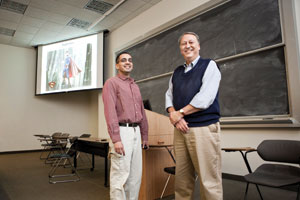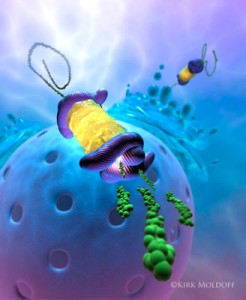Molecule makers
The collaborative work of two TCNJ professors could lead to the development of new and more efficient cancer-fighting drugs.

Professor David Hunt (right) and his team synthesized new compounds while Professor Sudhir Nayak (left) and his team created a novel method for testing the compounds’ effectiveness. Hunt said much of their work could be patentable.
The proteasome—a subcellular organelle that degrades unwanted and misfolded cellular proteins—is sort of like a microscopic garbage disposal, reasons biology Professor Sudhir Nayak. It functions in a similar fashion to a kitchen garbage disposal: chopping waste products into tiny pieces then spitting them out to be discarded or recycled. “It even looks like a garbage disposal,” Nayak said, referring to the proteasome’s cylindrical structure, which features an opening at one end where damaged proteins enter, a chamber in the middle that houses enzymes which do the “chopping,” and another opening at the opposite end where the shredded fragments exit.

When properly functioning, proteasomes play a key role in several cellular processes, including regulating the cell cycle, the process through which a cell divides and replicates. But Nayak and Professor David Hunt, chair of TCNJ‘s chemistry department, are more interested in the possibilities that arise when you inhibit the proteasome—or to put it another way, when you intentionally break that cellular garbage disposal.
“If I stick a rotting banana in a garbage disposal, flick the switch—bam, the banana is gone,” Nayak said. “But if I stick a few forks in there first, then keep stuffing bananas in there, the garbage will start piling up.
“When that happens in a cell, it’s toxic,” he continued. “The cell is shoving things into the proteasome that it needs to get rid of. So, if you can shut down that critical system, you can cause a buildup of waste, and the cell should die.” It’s a process called apoptosis, or programmed cell death.
“The good thing about this is that cells that divide rapidly need that garbage disposal the most—and cancer cells divide quickly and need to keep dividing to spread,” continued Nayak. So, by inhibiting the proteasome, you might be able to trigger apoptosis in cancer cells, thus causing the cells to kill themselves before they divide and spread.
Hunt and Nayak recently collaborated on a three-year effort to synthesize new proteasome-inhibiting compounds and create a novel screening procedure to rapidly test the effectiveness of such compounds. Their work could help pharmaceutical companies develop new and more efficient cancer-fighting drugs.
The project was inspired in part by Hunt’s work in industry. Prior to joining TCNJ’s faculty full time in 2005, he was involved in the discovery or development of more than 15 commercial products—one of which was Velcade, the first synthetic proteasome inhibitor approved by the Food and Drug Administration. During the course of his work, he learned there were a number of naturally occurring proteasome inhibitors, but most of them were too big molecularly to be viable for pharmacological use. Hunt thought it would be an “interesting project” to try to strip away some of that complexity and create smaller compounds that retained the active, proteasome-inhibiting component. He’d need a way to test his chemical creations in an organism, which is when Nayak came on board.
“Dave mentioned his interest in proteasome inhibitors, which was something I was also working on in my lab,” Nayak recalled. “One of the proteins I’m interested in is a target of the proteasome, and I wanted to stop the proteasome, which would cause a buildup of that protein, and see what happened.” At the same time, the project would give Nayak the opportunity to see if the model organism he worked with, a tiny ground worm called Caenorhabditis elegans (C. elegans), was amenable to a high-throughput screen (HTS).
The professors mapped out a program in which Hunt’s team would synthesize the new compounds, and Nayak’s team would create an HTS method to test if the compounds inhibited the proteasome in C. elegans. In 2007, the Merck Institute for Science Education and the American Association for the Advancement of Science awarded the professors a grant to pursue the research. The competitive, three-year grant is given annually to projects that enhance undergraduate education through research experiences emphasizing the interrelationship between chemistry and biology.

Hunt and his team set to work determining how much of the structural complexity they could strip away from the natural products, while retaining those parts of the molecule responsible for the biological activity. “By taking a natural molecule and using it as a template, there’s a chance you might end up with something that hits a different target…or you might end up making a compound that’s 10, or 100, or 1,000 times more active than the original,” the professor explained.
Hunt designed the compounds and let his students determine how to synthesize them. Erica Tabakin ’09, who worked on the project in 2007 and 2008 and is now a third-year student at UMDNJ–Robert Wood Johnson Medical School in New Brunswick, said it took anywhere from a few days to more than a week to synthesize the compounds. “There were some long reactions involved, and the purification process was lengthy.”
“Some were easier to make than others,” recalled Lyndsay Wood ’10, who worked on the project in 2009 and is now in the organic chemistry PhD program at the University of Pennsylvania. “If it’s chemistry that hasn’t been done before—and it had never been done on our type of substrate, because we were making novel compounds—there is no exact precedent to follow.”
After the molecules were synthesized and purified, the students used spectroscopy to determine if they’d hit their goal chemically and structurally, Tabakin said. The compounds that did were given to Nayak’s team for biological testing.
Nayak said he uses C. elegans in his lab for a number of reasons. They are easy to grow, nonpathogenic, and transparent. What’s more: They can be maintained as male or hermaphrodite strains, meaning the worms can make more of themselves, and have a rapid life cycle—just a few days from adults to new adults. Finally, the worm’s genome has been fully sequenced.
For his collaboration with Hunt, Nayak used a special strain of C. elegans in which the genes had been modified so that a specific protein glowed green when it was produced. He said it took two years to get the assay to the point where it was reliable and reproducible. “There was a lot of, ‘The worms won’t live in this medium,’ or, ‘We have to do this control.’” But once the HTS was in place, it significantly sped up the testing process. “Rather than having to test one chemical at a time, we could test 10 chemicals at 10 different dilutions in a single day,” explained Michela Fiaschi ’10, MAT ’11, who worked on the project in 2008 and now teaches biology in Pascack Valley (NJ) High School.
Testing the compounds was a two-step process, Fiaschi continued. “First, we looked to see if the protein increased in the cells. Then we looked to see if those cells were smart enough to undergo apoptosis,” Fiaschi said. The fluorescence allowed the team to easily observe, in real time, the molecular changes taking place. “We know C. elegans always has the same number of cells when it’s made,” said Fiaschi. “Because its cellular makeup is so consistent, we could look for specific cells where the protein was increased and see if those specific cells were dying—not just the whole worm was dying, because that would be defeating the purpose.”
Hunt said the team worked the project to a “good stopping point” prior to the grant running out, noting that they have a screen in place that showed a battery of the compounds they made inhibited the proteasome. “It’s proof of concept at this point, but there is a lot more work that can be done,” Hunt said, crediting the students with doing “graduate-level work” on the project. Added Nayak: “It’s ‘insanely uncommon’ for students to be involved in this level of research at the undergraduate level. It just doesn’t happen that often, and that’s part of what makes this institution unique.”
“The next step would be to see how these compounds actually behave against a tumor cell line,” Hunt said. Nayak, who used to work on cancer cell lines at the Wistar Institute prior to joining TCNJ’s faculty, concurred. But the biology professor said pursuing this next step would require more private or public funding. “We’d need a little more equipment, and the costs for maintaining the cell lines could run into the thousands of dollars per year, but it’s something we want to do.”
Still, Hunt said of the work done to date, “The details of the screen could be patentable, as could some of the compounds. There could be composition of matter on some of the compounds, and there could also be methods and use. There could be multiple compounds that come out of this work.”
Asked what that could mean down the road, Hunt offered this possible scenario: “What could come of something like this is if a large pharmaceutical company were interested, they could adopt the screen method, and could either buy the patent outright, or license it for use, or if any type of commercial product were to arise out of this intellectual property, the company could agree to some kind of royalty payment.
“That’s where a number of universities make a lot of money now, through this type of thing.”
Posted on March 7, 2012

